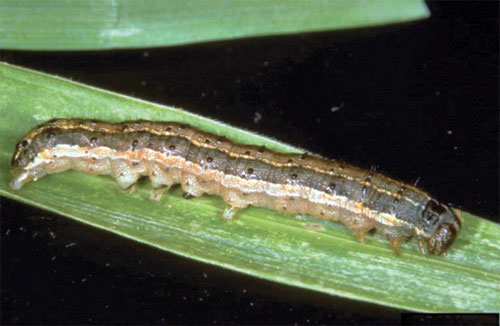Fall armyworms are munching their way across portions of the country, impacting pastures, hayfields and lawns.
An Extension agent in Alabama compared the invasion of armyworms in his area to “Sherman’s army going through Georgia.”
In the Ozarks, there have been reports made of fall armyworm, and farmers are being encouraged to scout their fields now in an effort to spot the caterpillars.
Pat Miller, a University of Missouri Extension agronomy specialist in Vernon County, Mo., said she has not received any reports in her area about armyworms, but that doesn’t mean they aren’t in area fields.
She said an infestation of fall armyworms can leave pastures appearing as if they have been “grazed into the ground,” which can weaken the stand.
“The bigger issue is in new seedings of fescue or alfalfa because the worms can just kill it out,” Miller added. “That can be a problem for a couple of seasons for many producers.”
According to the University of Missouri Extension, the fall armyworm does not overwinter in the Ozarks area, but migrates northward from the Gulf Coast. The first wave of migrants typically arrives in late June. Unlike true armyworm larvae, fall armyworm larvae also feed during the day and are particularly active in the early morning or late afternoon hours. This species generally requires 30 to 45 days to complete a generation.
Fall armyworm larvae can be distinguished from true armyworm larvae by:
• The absence of black spots at the base of the abdominal prolegs.
• Four black spots on the eighth abdominal segment
that form a square
• The presence of a pronounced inverted, white, Y-shaped mark
on the head.
Scouting is best done in the early morning hours, in the late evening, or on cloudy days because newly hatched larvae avoid light. The newly hatched larvae will feed on the lower leaves of plants to reduce light intensity.
“Nothing replaces scouting your own field,” Miller said. “What’s going on down the road or at your neighbor’s or another part of the state doesn’t mean you have something going on at your place, so it’s always good to scout – even if there haven’t been any reports in your area. Walk or drive across the pastures and see what is going on. If I had new seedings, I’d watch even closer.”
Cutting pastures or hayfields, or grazing will cause the worms to move on, but in cases were spraying is required, Miller reminded producers to check for any grazing restrictions before applying.
In addition to pastures, both true and fall armyworms are the primary armyworm that impacts corn.
As the larvae grow, they eat through the leaf, creating pin-sized holes. When the damaged leaves unfurl, they have a ragged appearance. Fall armyworms also damage corn by feeding on developing tassels, damaging immature ears and boring into stalks.
Fall armyworm outbreaks, according to information from the University of Arkansas, are more likely during periods of drought because some of their natural enemies are less active. Fall army worm outbreaks in Ozarks often occur as the grass greens from rain that has broken a prolonged dry period. Fall armyworm outbreaks may occur as early as July and continue into the fall. Well-fertilized Bermudagrass seems to be the preferred fall armyworm habitat. Although fall armyworms feed more actively in early morning and late afternoon, they may eat throughout most of the day in tall forage.




